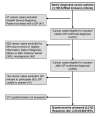Time intervals from first symptom to treatment of cancer: a cohort study of 2,212 newly diagnosed cancer patients
- PMID: 22027084
- PMCID: PMC3217887
- DOI: 10.1186/1472-6963-11-284
Time intervals from first symptom to treatment of cancer: a cohort study of 2,212 newly diagnosed cancer patients
Abstract
Background: Delay in diagnosis of cancer may worsen prognosis. The aim of this study is to explore patient-, general practitioner (GP)- and system-related delay in the interval from first cancer symptom to diagnosis and treatment, and to analyse the extent to which delays differ by cancer type.
Methods: Population-based cohort study conducted in 2004-05 in the County of Aarhus, Denmark (640,000 inhabitants). Data were collected from administrative registries and questionnaires completed by GPs on 2,212 cancer patients newly diagnosed during a 1-year period. Median delay (in days) with interquartile interval (IQI) was the main outcome measure.
Results: Median total delay was 98 days (IQI 57-168). Most of the total delay stemmed from patient (median 21 days (7-56)) and system delay (median 55 days (32-93)). Median GP delay was 0 (0-2) days. Total delay was shortest among patients with ovarian (median 60 days (45-112)) and breast cancer (median 65 days (39-106)) and longest among patients with prostate (median 130 days (89-254)) and bladder cancer (median 134 days (93-181)).
Conclusion: System delay accounted for a substantial part of the total delay experienced by cancer patients. This points to a need for shortening clinical pathways if possible. A long patient delay calls for research into patient awareness of cancer. For all delay components, special focus should be given to the 4th quartile of patients with the longest time intervals and we need research into the quality of the diagnostic work-up process. We found large variations in delay for different types of cancer. Improvements should therefore target both the population at large and the specific needs associated with individual cancer types and their symptoms.
© 2011 Hansen et al; licensee BioMed Central Ltd.
Figures
References
-
- Risberg T, Sorbye SW, Norum J, Wist EA. Diagnostic delay causes more psychological distress in female than in male cancer patients. Anticancer Res. 1996;11:995–999. - PubMed
Publication types
MeSH terms
LinkOut - more resources
Full Text Sources





